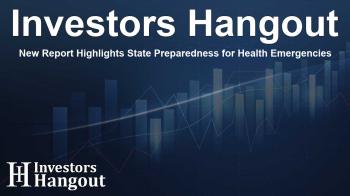New Report Highlights State Preparedness for Health Emergencies

Assessing State Preparedness for Health Emergencies
A recent report has highlighted the need for improved national and state preparedness to effectively protect residents' health during public health emergencies. It reveals that a concerning 29 states are categorized as either middle or low-performance in their emergency readiness. This underscores the importance of enhancing health infrastructure and emergency preparedness to ensure community safety and resilience.
Understanding the Findings
Throughout the previous year, the nation faced numerous public health crises, including infectious disease outbreaks and severe weather events. These incidents stress the urgent necessity for continuous investment in public health frameworks that bolster national health and economic security.
The report titled Ready or Not 2025: Protecting the Public's Health from Diseases, Disasters, and Bioterrorism meticulously evaluates states' preparedness across various health emergencies via 10 key indicators. These include the effectiveness of healthcare systems, public health funding levels, and community water system safety.
Performance Categories of States
This year’s analysis categorizes states and the District of Columbia into three performance tiers based on their emergency preparedness:
High-Performance Tier
The 21 states and DC recognized for their superior performance include:
CO, CT, DC, DE, FL, GA, ID, MA, MD, ME, MO, NC, NH, NJ, OH, PA, RI, UT, VA, VT, WA, WI.
Middle-Performance Tier
16 states demonstrated middle-tier performance, including:
AL, AR, AZ, CA, IA, IL, IN, KS, KY, ND, NE, NY, OK, SC, TN, TX.
Low-Performance Tier
The 13 states that fall into the low-performance category are:
AK, HI, LA, MI, MN, MS, MT, NV, NM, OR, SD, WV, WY.
Providing Guidance and Recommendations
This significant report not only offers insights but also sets benchmarks and provides policy recommendations that can aid various levels of government to bolster their emergency preparedness strategies. It’s clear that proactive planning and sustained funding are essential for communities facing potential health crises.
Dr. J. Nadine Gracia, President and CEO of Trust for America's Health, emphasized that "strengthening communities for public health emergencies demands consistent investment, strategic planning, and collaboration across sectors." This aligns with the findings showing the need for improved public health systems and community resilience in the face of emergencies.
Special Features Highlighting Health Threats
A prominent feature of the report addresses the H5N1 bird flu threat, examining the necessary measures to prevent it from escalating into a pandemic. It highlights recommendations from health professionals regarding the implementation of widespread testing and collaborative strategies between public health officials and agricultural sectors to mitigate the outbreak risks.
Identifying Areas for Improvement
The report shines a light on critical areas requiring attention, particularly regarding avoidable mortality, which refers to deaths that could have been prevented through better health access and interventions.
Strong Performance Indicators
Noteworthy strengths include an increase in states adopting the nurse licensure compact to ensure staffing flexibility during emergencies and a significant proportion of states achieving accreditation that fosters coordinated structures for emergency response.
Areas Requiring Focus
However, challenges persist. Many states face alarming rates of avoidable mortality, which showcase disparities in health access across the nation, particularly in the Southeast and parts of Appalachia. Moreover, funding reductions for public health in several states highlight the need for improved resource allocation and management.
Strategizing for the Future
The report puts forth a series of actionable recommendations designed to enhance public health emergency preparedness. These include:
- Ensuring stable funding for public health initiatives, including support for emergency preparedness.
- Reauthorizing relevant preparedness acts to enable better management of health threats.
- Targeting health disparity issues through improved demographic data collection.
- Boosting initiatives to strengthen community resilience against adverse health events.
By supporting these developments, healthcare systems can enhance their ability to respond to crises and work towards a healthier populace.
Frequently Asked Questions
What is the purpose of the report?
The report evaluates states' preparedness for health emergencies and provides recommendations for improvement.
Who published the report?
The report was published by Trust for America's Health, a respected nonpartisan public health organization.
What are the key performance indicators?
Ten key indicators were used to assess healthcare readiness, funding levels, and more.
How can communities improve their preparedness?
Investing in public health infrastructure and ensuring multi-sector collaboration are essential for enhancing readiness.
What are avoidable mortality rates?
Avoidable mortality refers to deaths that could be prevented with timely healthcare interventions.
About The Author
Contact Ryan Hughes privately here. Or send an email with ATTN: Ryan Hughes as the subject to contact@investorshangout.com.
About Investors Hangout
Investors Hangout is a leading online stock forum for financial discussion and learning, offering a wide range of free tools and resources. It draws in traders of all levels, who exchange market knowledge, investigate trading tactics, and keep an eye on industry developments in real time. Featuring financial articles, stock message boards, quotes, charts, company profiles, and live news updates. Through cooperative learning and a wealth of informational resources, it helps users from novices creating their first portfolios to experts honing their techniques. Join Investors Hangout today: https://investorshangout.com/
The content of this article is based on factual, publicly available information and does not represent legal, financial, or investment advice. Investors Hangout does not offer financial advice, and the author is not a licensed financial advisor. Consult a qualified advisor before making any financial or investment decisions based on this article. This article should not be considered advice to purchase, sell, or hold any securities or other investments. If any of the material provided here is inaccurate, please contact us for corrections.

